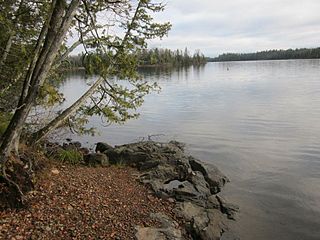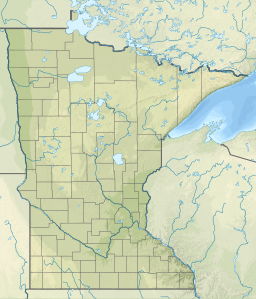
Trout Lake Township is located in north central Minnesota in Itasca County, United States. It is bordered by the City of Coleraine to the west and north, City of Bovey on the north, an unorganized township on the east, and Blackberry Township to the south. Town government was adopted on March 6, 1894. The population was 1,056 at the 2020 census.

Glacial Lakes State Park is a state park of Minnesota, USA, approximately 5 miles (8.0 km) south of Starbuck. It was founded in 1963 to preserve some of the remaining rolling prairie which previously covered much of the state. Located in the Leaf Mountains, the park and the area around it contains many glacial landforms created by the Wisconsonian glaciation.

The Lake Vermilion-Soudan Underground Mine State Park is a Minnesota state park at the site of the Soudan Underground Mine, on the south shore of Lake Vermilion, in the Vermilion Range (Minnesota). The mine is known as Minnesota's oldest, deepest, and richest iron mine, and now hosts the Soudan Underground Laboratory. As the Soudan Iron Mine, it has been designated a U.S. National Historic Landmark.

The Minnesota Department of Natural Resources, or Minnesota DNR, is the agency of the U.S. state of Minnesota charged with conserving and managing the state's natural resources. The agency maintains areas such as state parks, state forests, recreational trails, and recreation areas as well as managing minerals, wildlife, and forestry throughout the state. The agency is divided into six divisions - Ecological & Water Resources, Enforcement, Fish & Wildlife, Forestry, Lands & Minerals, and Parks & Trails.

The Graham Lakes are a pair of lakes located in the northeastern corner of Nobles County, Minnesota. The lakes are known as West Graham Lake and East Graham Lake. West Graham Lake is an oval shaped body of water that extends east-to-west slightly more than one mile (1.6 km). The north-to-south width of the lake is approximately 3/4 of a mile. The area of West Graham Lake is 519.28 acres (2.1015 km2), the average depth is 5 feet (1.5 m), and the maximum depth is 8 feet (2.4 m). The elevation of West Graham Lake is 1,438.7 feet (438.5 m), or 438.52 meters. East Graham Lake is a longer, narrower lake that extends from northeast-to-southwest for 11⁄2 miles. Its width is less than 1/2 mile. The area of East Graham Lake is 511.32 acres (2.0692 km2), the average depth is 5 feet (1.5 m), and the maximum depth is 8 feet (2.4 m). The elevation of East Graham Lake is 1,435.08 feet (437.41 m), or 437.41 meters. A small creek runs from West Graham Lake and empties into East Graham Lake. Another creek runs from East Graham Lake, and eventually flows into the Des Moines River.
The Battleground State Forest is a state forest located near Gould Township in Cass County, Minnesota. It is managed by the Minnesota Department of Natural Resources. It lies entirely within the boundaries of the Chippewa National Forest, additionally, and a portion of the forest falls within the borders of the Leech Lake Indian Reservation.
The Bear Island State Forest is a state forest in Minnesota bordered by the towns of Ely, Babbitt, and Tower in Lake and Saint Louis counties. It is adjacent to the Burntside State Forest and the federally managed Superior National Forest and Boundary Waters Canoe Area Wilderness. It is managed primarily by the Minnesota Department of Natural Resources and the counties.
The Big Fork State Forest is a state forest located in Koochiching and Itasca counties, Minnesota. It is primarily managed by the Minnesota Department of Natural Resources. The landscape has many moraines, lakes, and wetlands. The "Lost 40" and the largest red pine in the state of Minnesota are located within the forest.
The Bowstring State Forest is a state forest located in Itasca and Cass Counties in Minnesota. It is located entirely within the boundaries of the federally managed Chippewa National Forest, and is managed by the Minnesota Department of Natural Resources.

Crescent Lake is a lake located in Tofte Township and Lutsen Township, Cook County, Minnesota.
Iowa Lake is a 30-acre lake in Cook County, Minnesota which is a tributary to the Poplar River. It has a maximum depth of 13 feet and is clear down to 7 feet. Water access is provided by a portage trail leading to its northeast shore. The lake is fed primarily by a stream on its northwest shore, with secondary intake coming from a pond of less than 100 feet to the north and an intermittent stream located to the south of the portage trail. Its outlet, on the south, empties into Corny Lake through a wetland area. A 1972 survey by Minnesota's DNR indicated the presence of a beaver lodge on the south outlet, and multiple beaver dams along the course of the creek have converted patches of the marsh into open water. A 1971 survey by the fisheries department indicated the lake was home to populations of northern pike, white sucker, and yellow perch.
Manymoon Lake is a 24-acre lake in Cook County, Minnesota belonging to the Poplar River watershed. At its deepest point it measures only 6.5 feet deep and has abundant aquatic plant life to a depth of 2.5 feet. Water clarity as of 2008 measured 1.41 meters. The substrate consists of muck and stones of no uniform size. Manymoon lake has neither inlet nor permanent outlet, although an intermittent stream feeds a wetland on the end of the southeastern bay. Nonetheless, Manymoon is located in the sub-watershed dominated by Rice Lake to the north, and water from Manymoon enters into lower portions of the Poplar River through Rice Lake's outflow. Manymoon is accessible through a portage off Rice Lake Road.
Anderson Lake is a 28-acre lake in Cook County, Minnesota which is a tributary to the Poplar River. It consists of a western lobe of 15 acres and an eastern lobe of 13 acres. Anderson Lake should not be confused with the Anderson Lake which is a tributary to the Temperance River and lies slightly more than one mile northwest.
Silver Lake is a 22-acre lake in Cook County, Minnesota which is a tributary to the Poplar River. Silver Lake is six feet deep and has clarity down to 4.5 feet. It has one inflow from Bulge Lake, and drains into Rice Lake South of the inflow on the northwest shore, most of the west shore is a brush bog. Silver Lake has a shoreline of 1.1 miles.
Bulge Lake is a 12-acre lake in Cook County, Minnesota which is a tributary to the Poplar River. Bulge Lake reaches a maximum depth of 19 feet in a sudden depression just west of the mouth of the stream leading to Dogtrot Lake. Bulge lake is accessible through portages to Silver Lake and Dogtrot Lake. A fisheries survey turned up populations of walleye, northern pike, yellow perch, and white suckers.
Slip Lake is a 22-acre lake in Cook County, Minnesota which is a tributary to the Poplar River. Slip Lake reaches a maximum depth of 18 feet in a depression just south of the mouth of the stream leading to Fleck Lake. Slip Lake is accessible through portages to Dogtrot Lake and Fleck Lake. A fisheries survey turned up populations of walleye, northern pike, yellow perch, and white suckers.
Bouder Lake is a 129 acres (52 ha) lake in Cook County, Minnesota and a tributary of the Poplar River. Bouder Lake reaches a maximum depth of 17 feet (5.2 m). Bouder is accessible through a navigable channel leading into Crescent Lake. A fisheries survey turned up populations of walleye, muskellunge, smallmouth bass, yellow perch, and white suckers. An aquatic plants survey found the lake to be home to several species of water marigolds, pondweed, bladderwort, water lily, burreed, sedges, and cattails.
Chippewa Moraine Lakes is a Wisconsin Department of Natural Resources-designated State Natural Area that comprises nine separate sites, spread out over roughly 30 square miles (78 km2). Each site features a primarily undisturbed lake located within the rough terminal moraine topography of northern Chippewa County. Each lake has its own unique species assemblage due to physical and chemical characteristics of the lake. The nine lakes are: Camp Lake, a 6-acre lake ringed by a floating sphagnum bog mat containing such plant species as white beak rush, narrow-leaved sundew, small cranberry, and grass pink orchid. Spence Lake, a 12-acre, acidic bog lake that is the headwaters of Foster Creek. Conifer swamp surrounds the northern part of the lake, hardwood swamp surrounds the central part, while the southern part is largely a sedge meadow, impacted by beaver activity. Bass Lake #1, a 6-acre soft-water seepage lake, with at least one rare plant species present. Bass Lake #5, an 8-acre, deep, hard-water seepage lake that is the main headwaters branch of Mud Creek. Deer Lake, a 6-acre seepage lake that is also part of the headwaters of Mud Creek. Burnt Wagon Lake, a 15-acre softwater seepage lake that is landlocked, with no development. Fishpole Lake, an 11-acre meromictic lake. Due to its size, shape, and depth, the lake's water column is permanently thermally stratified, unlike most Wisconsin lakes, leading to unique chemical and biological characteristics. Plummer Lake, a 41-acre, deep, hard-water seepage lake. Little Plummer Lake, a 10-acre wild hardwater seepage lake that drains into Plummer Lake.






